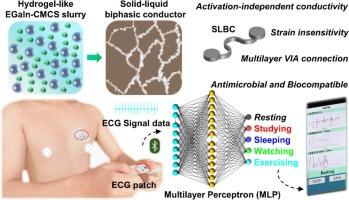Activation-independent biphasic liquid metal conductor enables multilayer stretchable electronics
IF 22
1区 材料科学
Q1 MATERIALS SCIENCE, MULTIDISCIPLINARY
引用次数: 0
Abstract
Liquid metal-based polymer composites are extensively employed in diverse stretchable electronics. Achieving initial conductivity and strain insensitivity typically necessitates activation or sintering. Therefore, the development of a facile, activation-independent stretchable conductor is critical for advancing liquid metal-based polymer composites. However, the mechanisms underlying activation-independent initial conductivity and strain insensitivity in these liquid metal-based conductors remain unclear and require further investigation. Furthermore, antibacterial properties and biocompatibility are essential for strain-insensitive conductors to reduce microbial infection risks and ensure safe interaction with biological tissues. Here, we present the synthesis of a two-component hydrogel-like liquid metal composite slurry without additional conductive components. The resulting solid–liquid biphasic conductor (SLBC), patterned from the slurry, exhibits a network topology with activation-independent initial conductivity (20974 S/cm), strain insensitivity (R/R0 ≈ 21.12 at 2200 % strain), excellent cyclic stability (over 40,000 cycles), multilayer vertical interconnect accesses (VIA) connectivity, and antibacterial properties and biocompatibility. Additionally, we developed a multilayer stretchable wireless ECG patch that facilitates real-time monitoring of personal states via a deep learning model, demonstrating the reliability, versatility, and practicality of the SLBC.

非激活双相液态金属导体实现多层可拉伸电子器件
液态金属基聚合物复合材料广泛应用于各种可拉伸电子产品中。实现初始电导率和应变不敏感通常需要激活或烧结。因此,开发一种轻便的、不依赖于活化的可拉伸导体对于推进液态金属基聚合物复合材料至关重要。然而,这些液态金属基导体中不依赖激活的初始电导率和应变不敏感的机制尚不清楚,需要进一步研究。此外,抗菌性能和生物相容性对于降低微生物感染风险和确保与生物组织的安全相互作用至关重要。在这里,我们提出了一种双组分水凝胶状液态金属复合浆料的合成,没有额外的导电成分。由浆料制成的固液双相导体(SLBC)具有与活化无关的初始电导率(20974 S/cm)、应变不敏感(在2200%应变下R/R0≈21.12)、出色的循环稳定性(超过40,000次循环)、多层垂直互连通道(VIA)连接性、抗菌性能和生物相容性。此外,我们还开发了一种多层可拉伸无线ECG贴片,通过深度学习模型促进对个人状态的实时监测,展示了SLBC的可靠性、多功能性和实用性。
本文章由计算机程序翻译,如有差异,请以英文原文为准。
求助全文
约1分钟内获得全文
求助全文
来源期刊

Materials Today
工程技术-材料科学:综合
CiteScore
36.30
自引率
1.20%
发文量
237
审稿时长
23 days
期刊介绍:
Materials Today is the leading journal in the Materials Today family, focusing on the latest and most impactful work in the materials science community. With a reputation for excellence in news and reviews, the journal has now expanded its coverage to include original research and aims to be at the forefront of the field.
We welcome comprehensive articles, short communications, and review articles from established leaders in the rapidly evolving fields of materials science and related disciplines. We strive to provide authors with rigorous peer review, fast publication, and maximum exposure for their work. While we only accept the most significant manuscripts, our speedy evaluation process ensures that there are no unnecessary publication delays.
 求助内容:
求助内容: 应助结果提醒方式:
应助结果提醒方式:


